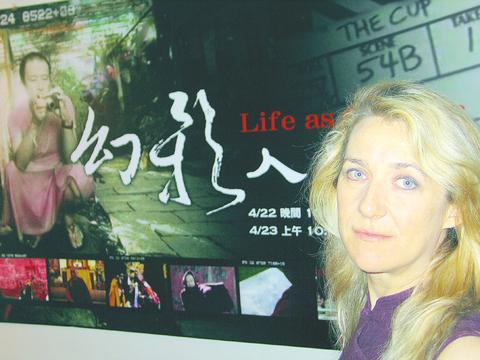Life as Cinema by Anika Tokarchuk is a 56-minute documentary about the making of The Cup (1999) (高山上的足球盃), the debut feature film of Dzongsar Khyentse Rinpoche (aka Khyentse Norbu).
Dzongsar Khyentse Rinpoche, a spiritual director of several Buddhist colleges in India, Bhutan and Sikkim, is recognized in his culture as the third incarnation of the Khyentse lineage of Tibetan Buddhism. Life as Cinema voices his Buddhist reflections on the impermanence of life.

PHOTO: BEN ZULLO
The film begins with Dzongsar Khyentse Rinpoche making a shadow butterfly on the wall with his hands. While the butterfly's magnified shadow flaps its dark wings on a white wall, he asks, "How do you know this is a butterfly?"
The shadow on the wall is like reality projected on the screen of our mind. The layers of illusion and reality are interwoven into each other. While the theme of illusion is dominant in the film, the encounter between modernity and tradition in everyday Tibetan culture is also telescoped into Dzongsar Khyentse Rinpoche's character.
Educated in London and given his first movie-related job by Bernardo Bertolucci in Little Buddha, Dzongsar Khyentse Rinpoch rides the tide of westernization and redefines his role as a Rinpoche.
When Tokarchuk informs the Dalai Lama that Dzongsar Khyentse Rinpoche is making a feature film based on the real events of the monks at Dzongsar Institute, he breaks into laughter commenting, "Oh, I see, lamas are actors now."
As she reveals in her documentary, the actors in The Cup are all from a real monastery and cast by their ecclesiastical superior. (Dzongsar Khyentse Rinpoche coaxed 14-year-old Jamyang Lodro into playing the role of Orgyen in The Cup with a promise of taking him to Disneyland.)
Jovial and with a sense of absurdity, Life as Cinema rings quiet notes of political urgency. Unlike other dramas on Tibet such as Kundun (1997) and Seven Years in Tibet (1997), Tokarchuk does not portray Tibet as mired in Chinese suppression. Instead, Life as Cinema tracks the footsteps of Tibetan Buddhists to India, France, England, Canada, Hong Kong, and of course Taiwan.
It is, after all, a documentary on Tibet-on-the-move, a film on the nature of change and openness.
The second part of the trilogy will go into the background of Dzongsar monastery in Tibet and focus on Karpu Lama, a Tibetan who now lives in Taiwan.
In a partial preview, Karpu's exile from Tibet is captured in a soliloquy that drifts across beautifully crafted images of Tibetan valleys and Taipei's streets. "Life is dreamlike," says Tokarchuk, "but it is also telling a history."
For your information :
There will be a free public screening of Life as Cinema at the Wisteria Tea House (

Most heroes are remembered for the battles they fought. Taiwan’s Black Bat Squadron is remembered for flying into Chinese airspace 838 times between 1953 and 1967, and for the 148 men whose sacrifice bought the intelligence that kept Taiwan secure. Two-thirds of the squadron died carrying out missions most people wouldn’t learn about for another 40 years. The squadron lost 15 aircraft and 148 crew members over those 14 years, making it the deadliest unit in Taiwan’s military history by casualty rate. They flew at night, often at low altitudes, straight into some of the most heavily defended airspace in Asia.

Beijing’s ironic, abusive tantrums aimed at Japan since Japanese Prime Minister Sanae Takaichi publicly stated that a Taiwan contingency would be an existential crisis for Japan, have revealed for all the world to see that the People’s Republic of China (PRC) lusts after Okinawa. We all owe Takaichi a debt of thanks for getting the PRC to make that public. The PRC and its netizens, taking their cue from the Chinese Communist Party (CCP), are presenting Okinawa by mirroring the claims about Taiwan. Official PRC propaganda organs began to wax lyrical about Okinawa’s “unsettled status” beginning last month. A Global

Taiwan’s democracy is at risk. Be very alarmed. This is not a drill. The current constitutional crisis progressed slowly, then suddenly. Political tensions, partisan hostility and emotions are all running high right when cool heads and calm negotiation are most needed. Oxford defines brinkmanship as: “The art or practice of pursuing a dangerous policy to the limits of safety before stopping, especially in politics.” It says the term comes from a quote from a 1956 Cold War interview with then-American Secretary of State John Foster Dulles, when he said: ‘The ability to get to the verge without getting into the war is

Like much in the world today, theater has experienced major disruptions over the six years since COVID-19. The pandemic, the war in Ukraine and social media have created a new normal of geopolitical and information uncertainty, and the performing arts are not immune to these effects. “Ten years ago people wanted to come to the theater to engage with important issues, but now the Internet allows them to engage with those issues powerfully and immediately,” said Faith Tan, programming director of the Esplanade in Singapore, speaking last week in Japan. “One reaction to unpredictability has been a renewed emphasis on